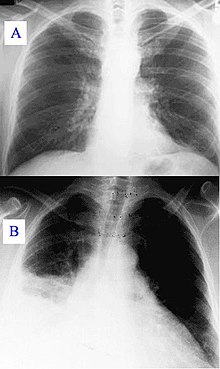
Hospital-acquired pneumonia (HAP) or nosocomial pneumonia refers to any pneumonia contracted by a patient in a hospital at least 48–72 hours after being admitted. It is thus distinguished from community-acquired pneumonia. It is usually caused by a bacterial infection, rather than a virus.[1][2]
Hospital acquired pneumonia is the second most common nosocomial infection (after urinary tract infections) and accounts for 15–20% of the total.[1][2][3] It is the most common cause of death among nosocomial infections and is the primary cause of death in intensive care units.[1][3] It is also one of the most common infections acquired at the hospital in children around the world.[4]
Hospital acquired pneumonia typically lengthens a hospital stay by 1–2 weeks.[1][3]
- ^ a b c d Mandell's Principles and Practices of Infection Diseases Archived 2013-10-18 at the Wayback Machine 6th Edition (2004) by Gerald L. Mandell MD, MACP, John E. Bennett MD, Raphael Dolin MD, ISBN 0-443-06643-4 · Hardback · 4016 Pages Churchill Livingstone
- ^ a b The Oxford Textbook of Medicine Archived 2006-09-23 at the Wayback Machine Edited by David A. Warrell, Timothy M. Cox and John D. Firth with Edward J. Benz, Fourth Edition (2003), Oxford University Press, ISBN 0-19-262922-0
- ^ a b c Harrison's Principles of Internal Medicine Archived 2012-08-04 at the Wayback Machine 16th Edition, The McGraw-Hill Companies, ISBN 0-07-140235-7
- ^ Korang, Steven Kwasi; Nava, Chiara; Mohana, Sutharshini Punniyamoorthy; Nygaard, Ulrikka; Jakobsen, Janus C. (2021-11-02). "Antibiotics for hospital-acquired pneumonia in neonates and children". The Cochrane Database of Systematic Reviews. 2021 (11): CD013864. doi:10.1002/14651858.CD013864.pub2. ISSN 1469-493X. PMC 8562877. PMID 34727368.